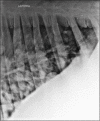Comparison of radiography and ultrasonography in the detection of lung and liver cysts in cattle and buffaloes
- PMID: 27847421
- PMCID: PMC5104720
- DOI: 10.14202/vetworld.2016.1113-1120
Comparison of radiography and ultrasonography in the detection of lung and liver cysts in cattle and buffaloes
Abstract
Aim: Echinococcosis is the major cause of lung and liver cysts in ruminants. This study compared usefulness of radiography and ultrasonography (USG) in the detection of lung and/or liver cysts in sick bovine animals. The study also worked out cooccurrence of lung and liver cysts, and whether these cysts were primary cause of sickness or not.
Materials and methods: This study was conducted on 45 sick bovine (37 buffaloes and 8 cattle) suffering from lung and liver cysts. A complete history of illness and clinical examination was carried out. Lateral radiographs of chest and reticular region were taken. In radiographically positive or suspected cases of cysts, USG of the lung and liver region was done. Depending on the location of cyst and clinical manifestations of the animal, the cysts were categorized as primary or secondary causes of sickness.
Results: Using either imaging technique, it was observed that 46.7% of the animals had both lung and liver cysts, whereas 33.3% had only lung and 20% had only liver cyst. Cysts were identified as primary cause of sickness in 31.1% animals only. For diagnosing lung cysts, radiography (71.1%) and USG (62.2%) had similar diagnostic utility. However, for detecting liver cysts, USG was the only imaging tool.
Conclusion: The lung and liver cysts, depending on their number and size may be a primary cause of sickness in bovine. Radiography and USG are recommended, in combination, as screening tools to rule out echinococcosis.
Keywords: bovine; echinococcus cyst; liver; lung; radiography; ultrasound.
Figures















References
-
- Moro P, Schantz P.M. Echinococcosis: A review. Int. J. Infect. Dis. 2009;13(2):125–133. - PubMed
-
- Cardona G.A, Carmena D. A review of global prevalence, molecular epidemiology and economics of cystic echinococcosis in production animals. Vet. Parasitol. 2013;192(1):10–32. - PubMed
-
- Verma Y, Swami M. Prevalence and pathology of hydatidosis in buffalo liver. Buffalo Bull. 2009;28(4):207–211.
-
- Jayathilakan N, Basith S.A, John L, Chandaran N.D.L, Raj G.D. Development and evaluation of flow through technique for diagnosis of cystic echinococcosis in cattle. Vet Arch. 2010;80(5):549–559. - PubMed
-
- Singh B.B, Sharma R, Sharma J.K, Juyal P.D. Parasitic zoonoses in India: An overview. Rev. Sci. Tech. 2010;29(3):629–637. - PubMed
LinkOut - more resources
Full Text Sources
Other Literature Sources
